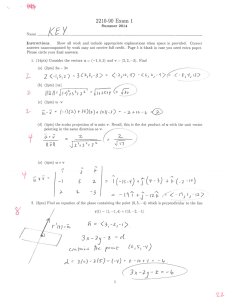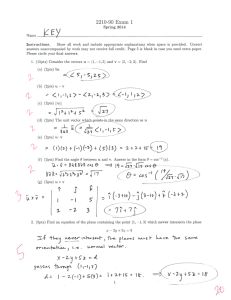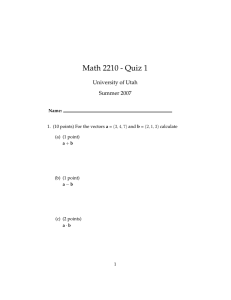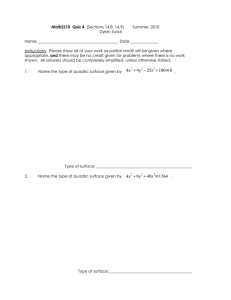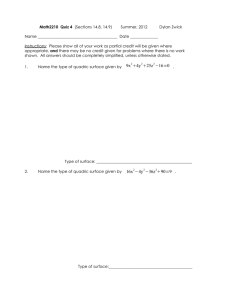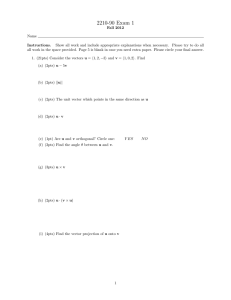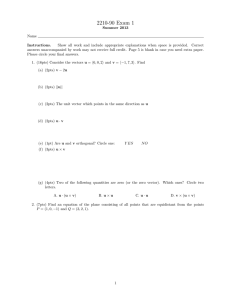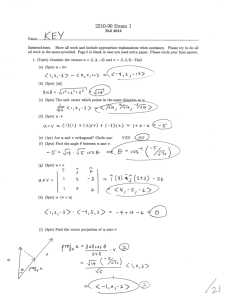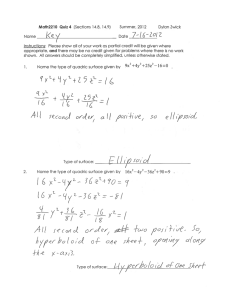2210-90 Exam 1
advertisement
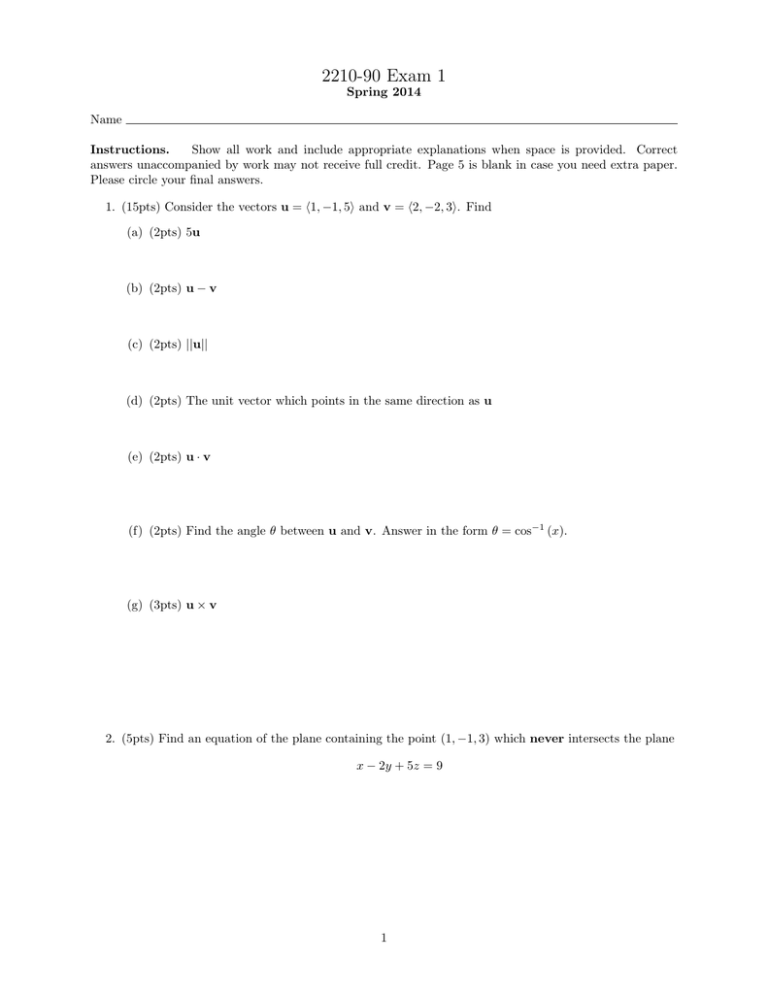
2210-90 Exam 1 Spring 2014 Name Instructions. Show all work and include appropriate explanations when space is provided. Correct answers unaccompanied by work may not receive full credit. Page 5 is blank in case you need extra paper. Please circle your final answers. 1. (15pts) Consider the vectors u = h1, −1, 5i and v = h2, −2, 3i. Find (a) (2pts) 5u (b) (2pts) u − v (c) (2pts) ||u|| (d) (2pts) The unit vector which points in the same direction as u (e) (2pts) u · v (f) (2pts) Find the angle θ between u and v. Answer in the form θ = cos−1 (x). (g) (3pts) u × v 2. (5pts) Find an equation of the plane containing the point (1, −1, 3) which never intersects the plane x − 2y + 5z = 9 1 3. (6pts) The line segment connecting (0, 2, −4) to (2, 2, 6) is a diameter of a sphere. Find an equation of this sphere. 4. (12pts) Suppose a particle’s position at time t is given by the curve r(t) = 6ti + 9j + (t2 + 1)k. (a) (2pts) Find the velocity v(t) = r0 (t) of the particle at time t. (b) (3pts) Set up an integral which gives the arc length of the curve between times t = 0 and t = 7. Do not evaluate. (c) (2pts) Find the acceleration a(t) = r00 (t) of the particle at time t. (d) (5pts) Find the curvature κ(t) = ||r0 (t)×r00 (t)|| ||r0 (t)||3 of the particle’s path at time t. 5. (6pts) Suppose the velocity of a particle is given by v(t) = hsin t, et , 3 cos ti. If the particle’s initial position is r(0) = h1, 1, 3i, where is the particle at time t = π? 2 6. (14pts) Match the equation with the type of surface it determines by writing the appropriate capital letter (A-G) in the provided blank. Each letter should be used exactly once. z = 9x − y + 7 2 y = x + 5z A Elliptic Paraboloid 2 B Ellipsoid 2x2 + y 2 + 9z 2 = 3 2 2 2 2 C Hyperboloid of one sheet y −x −z =1 D Hyperboloid of two sheets 2 x +y +z =3 2 2 E Hyperbolic Paraboloid 2 x + 2y − z = 1 F Plane x2 − 2y 2 − z 2 = 1 G Sphere 7. (8pts) Match the equation and the description of the surface by writing the appropriate capital letter (A-D) in the provided blank. Each letter should be used exactly once. (a) In cylindrical coordinates, the surface r = 4. (b) In cylindrical coordinates, the surface r2 − z 2 = 4. (c) In spherical coordinates, the surface φ = (d) In spherical coordinates, the surface ρ = 4. A a sphere. B a plane. C a cylinder. D a hyperboloid. π 2. 8. (9pts) Convert between Cartesian, cylindrical, and spherical coordinates as indicated. Please simplify as much as possible. (a) Find the cylindrical coordinates of the point with Cartesian coordinates (−1, −1, 5) r= θ= z= √ √ √ (b) Find the spherical coordinates of the point with Cartesian coordinates ( 2, 2, 2 3) ρ= θ= φ= √ (c) Find the Cartesian coordinates of the point with cylindrical coordinates (2, − π3 , 3) x= y= 3 z= 9. (12pts) Evaluate the following limits. If they do not exist, write ‘DNE’ and explain why. (a) lim ln (x2 + y 2 + 1) (x,y)→(0,0) (b) (c) (x + 2y)2 (x,y)→(0,0) x2 + 4y 2 lim lim (x,y)→(0,0) x2 y3 + y2 Hint: Use polar coordinates. 10. (13pts) Consider the function f (x, y) = xe−3y + x2 y 2 . (a) (7pts) Find the equation of the tangent plane to the graph of z = f (x, y) at the point (1, 0, 1). (b) (6pts) Find the following second derivatives: i. fxx (x, y) = ii. fyy (x, y) = iii. fxy (x, y) = 4

